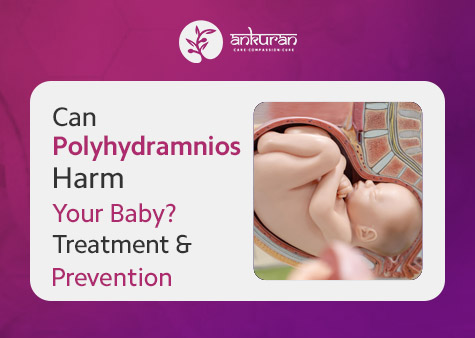Pregnancy is a time of excitement and hope, but it can also come with unexpected challenges. One such condition is polyhydramnios—a medical term that means there’s too much amniotic fluid around the baby. While it’s not something every expectant mother will face, it’s important to understand what it is, why it happens, and how it can affect both mother and child. While it is not very common, it can lead to complications if not identified and managed appropriately. The condition can range from mild to severe and may be caused by various underlying factors, including maternal health conditions or fetal abnormalities. Early detection and proper care are essential to ensure the well-being of both mother and baby.
Let’s explore this condition using common concerns that expecting parents often have
What is the Presence of Polyhydramnios?
In simple terms, polyhydramnios means your body is producing more amniotic fluid than necessary. This fluid cushions and protects your baby in the womb, but too much of it can sometimes signal underlying health issues. It’s usually diagnosed during an ultrasound when the amniotic fluid index (AFI) goes above 24 cm or when the deepest vertical pocket (DVP) measures more than 8 cm.
What is the Normal Amount of Amniotic Fluid?
During a healthy pregnancy, amniotic fluid usually ranges between 500 to 1,000 mL in the third trimester. It plays a key role in your baby’s lung development, movement, and temperature regulation.
At around 32 weeks, the average amount is roughly 800 mL, and an AFI between 8–18 cm is considered within the normal range. Anything significantly higher may point to mild or moderate polyhydramnios.
How Much Amniotic Fluid is Normal at 32 Weeks?
At 32 weeks gestation, the average amount of amniotic fluid should be around 800 mL. An AFI between 8–18 cm is considered normal during this stage. Values exceeding this may indicate mild polyhydramnios, which ranges from 24–29 cm on AFI.
Breathless During Pregnancy?
Don’t Delay, Get Checked
What is the Most Common Cause of Polyhydramnios?
Here’s where it gets tricky—most cases have no known cause. Doctors call these cases “idiopathic,” and they make up about 60% of all diagnoses. But when a reason is found, gestational diabetes is often the culprit. High blood sugar levels in the mother can cause the baby to urinate more, leading to an excess of fluid in the womb.
Other causes include:
- Fetal abnormalities (especially those affecting the baby’s ability to swallow fluid)
- Multiple pregnancies
- Infections or Rh incompatibility
In rare cases, genetic conditions such as Down syndrome may also be linked.
Does Drinking Water Increase Amniotic Fluid?
While adequate hydration is important during pregnancy, drinking excess water does not directly lead to polyhydramnios. However, in certain studies, maternal hydration has been associated with mild increases in amniotic fluid in cases of low fluid (oligohydramnios), not excess.
Which Fetal Abnormality is Responsible for Polyhydramnios?
Congenital abnormalities, especially those that impair the fetus’s ability to swallow amniotic fluid, can cause polyhydramnios. The most common include:
- Esophageal atresia
- Anencephaly
- Neuromuscular disorders
- Chromosomal anomalies such as Down syndrome
Facing High-Risk Pregnancy? Consult Our Fetal Medicine Specialists Today!

How to Treat Polyhydramnios?
Polyhydramnios treatment depends on the severity and underlying cause:
- Mild cases often don’t need active treatment—just more frequent ultrasounds.
- In moderate to severe cases, treatment may include:
- Blood sugar management for diabetic mothers
- Indomethacin (a medication that reduces fetal urine production)
- Amnioreduction, a procedure to remove excess fluid
- Close monitoring or hospitalization, especially after 34 weeks
How Can Amniotic Fluid Levels Be Lowered During Pregnancy?
Reducing fluid levels often involves:
- Controlling gestational diabetes
- Use of medications like indomethacin (under strict medical supervision)
- In rare cases, amnioreduction may be necessary
Lifestyle measures like balanced diet, reducing salt intake, and resting in a left lateral position can support better outcomes but do not directly reduce fluid levels.
Can Polyhydramnios Disappear?
Yes, in some cases, especially with mild polyhydramnios, the condition can resolve on its own. Regular monitoring ensures that any increase in fluid is caught early, and interventions can be initiated if needed.
What is the Side Effect of Polyhydramnios?
Polyhydramnios complications can include:
- Preterm labor
- Premature rupture of membranes
- Umbilical cord prolapse
- Placental abruption
- Increased risk of cesarean delivery
- Fetal malposition (breech or transverse lie)
Can a Baby Survive Polyhydramnios?
Yes, most babies born to mothers with well-managed polyhydramnios survive and thrive. However, outcomes depend on whether the baby has any underlying abnormalities and how early and effectively the condition is managed.
When to Worry About Polyhydramnios?
Concerns arise when:
- You feel excessive abdominal tightness
- There is difficulty breathing
- Uterine size is larger than gestational age
- You experience contractions before 37 weeks
Immediate evaluation is essential if you experience sudden fluid leakage or decreased fetal movements.
Is Polyhydramnios High Risk?
Yes, polyhydramnios is classified as a high-risk pregnancy, especially when fluid levels continue to rise or an underlying cause is found. This is why consistent follow-ups, scans, and sometimes early delivery may be recommended.
Who is at Risk for Polyhydramnios?
Several factors raise the risk:
- Uncontrolled gestational diabetes
- Twin or multiple pregnancies
- Fetal abnormalities
- Rh incompatibility
- Maternal infections
Women with these risk factors should undergo more frequent ultrasounds and glucose testing.
How to Avoid Polyhydramnios?
While not all cases can be prevented, the risk can be reduced by:
- Managing diabetes effectively during pregnancy
- Attending regular antenatal check-ups
- Getting timely fetal anomaly scans
- Avoiding infections through good hygiene and vaccinations
- Monitoring fetal movements from the third trimester onwards
Conclusion: Trusted Care at Ankuran IVF Clinic
Polyhydramnios is not just a term—it’s a condition that demands expert care. While many cases are idiopathic and may resolve on their own, some require close surveillance and intervention. Indian studies have shown that congenital anomalies and malpositions are common in polyhydramnios, leading to increased cesarean rates. Despite advanced testing, many cases still remain unexplained, underlining the importance of specialized care.
At Ankuran IVF Clinic, we provide comprehensive high-risk pregnancy support—from early polyhydramnios diagnosis to advanced treatment plans tailored for mother and baby. With a team of experienced obstetricians, fetal medicine experts, and the latest technology, we ensure you’re never alone on this journey.
If you’ve been diagnosed with polyhydramnios or are concerned about your pregnancy, don’t delay. Reach out to Ankuran IVF Clinic today and give your baby the best start to life.
Latest Resources
- Cervical Cerclage: Is It Major Surgery, When It’s Done and What Happens
- What Is Sperm DNA Fragmentation and Why Does It Matter
- Painless Normal Delivery: What It Is and How an Epidural Makes Birth Comfortable
- Placenta Previa in the Second Trimester — How Often Does It Resolve?
- Best Fetal Brain Development Food: What Every Mom Should Know



No Comments